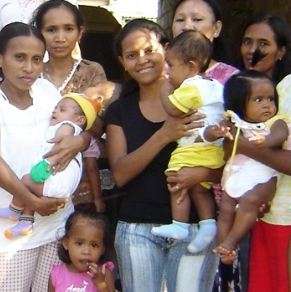Timor-Leste's population bubble – dividend or danger?

A Flinders demographer this week will tell the government of Timor-Leste that the population 'bubble' caused by soaring birth rates after independence in 2000 could potentially lead to an economic dividend for the young island nation.
However, Dr Udoy Saikia warned that if Timor-Leste does not respond to its current demographic challenges through adequate investment in human capital in this early stage of demographic transition, then the country is likely to experience increased poverty, environmental degradation and risks of violent conflict.
Director of Applied Population Studies program in the School of the Environment, Dr Saikia said that from an already high base of 5.3 during its time as an Indonesian province, Timor-Leste's fertility rate – the number of births per mother in the reproductive age group – grew after independence to reach an extraordinary average level of 7.8, one of the highest in the world, in 2003. It currently sits at 5.7.
Dr Saikia recently completed an updated projection (originally commissioned by Australia's Defence Science and Technology Organisation) of population growth and its implications for the Timor-Leste that suggests that the current population of close to 1.2 million will reach 1.4 million by 2020, and that the increase could double to around 1.82 million by 2030.
Analysis of rapid population growth points to serious issues for Timor-Leste, including social problems associated with potential mass unemployment among the nation's youth.
"We are projecting that at the current rate of growth, 18,000 new jobs need to be created every year for the young population," Dr Saikia said.
He said that given the number of formal jobs created in 2008 was around 400, there is "a big gap".
But given the right government strategies, including disciplined use of its oil revenues to invest in education, Dr Saikia said that Timor-Leste could emulate the social and economic success of South Korea, which had treated its high birth rates as a "demographic dividend" by heavily investing in youth education and training.
The Flinders team, which comprises Dr Saikia, Associate Professor Gour Dasvarma, Dr Merve Hosgelen and Dr James Chalmers, was invited to present its findings to the Timor-Leste Government by the acting Prime Minister, Mr Agio Pereira. Mr Pereira was a keynote speaker at two conferences on transitional nations in the Asia Pacific organised by Flinders that were held in Adelaide in 2010 and 2011.
"What we are proposing to them is that we will organise a skills program to train local people in survey techniques, so that they can assist us in new research projects on the population, youth bulge and human well-being," Dr Saikia said.
Timor-Leste has already demonstrated its ability to respond to social challenges: Dr Saikia said that faced with a total absence of doctors after independence, the Government negotiated a program with Cuba that has since trained hundreds of East Timorese as GPs.
Reducing fertility levels may take longer to address, Dr Saikia said. His field research and focus groups identified a strong cultural belief among East Timorese supporting bigger family size.
"If you ask East Timorese women, or their husbands, how many children they would like to have, the answer is almost always six or seven," Dr Saikia said.
"There are, however, some encouraging signs of declining birth rate in recent years, and with the commitment from the Timor-Leste Government as stated in their strategic plan 2011-2030, there is every possibility that the country can transform the current demographic concerns to future demographic dividend."
"It is highly important that we view the growing young Timorese as an opportunity rather than a burden, as otherwise their unmet aspirations can severely hamper the nation building process."
Provided by Flinders University


















